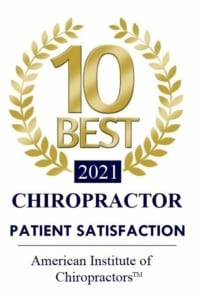Degenerative Spondylolisthesis
Understanding Degenerative Spondylolisthesis
Degenerative spondylolisthesis, a long name for a common problem. In this article, we answer your questions about this condition.
Who gets Degenerative Spondylolisthesis?
Degenerative Spondylolisthesis (DS) is a fairly common condition we diagnose, most often occurring in the lumbar spine and affecting females more often than males. In fact, 20% of women will develop this condition by age 45.
What causes Degenerative Spondylolisthesis?
This condition is usually caused by a degenerating or injured intervertebral disc, which in turn causes premature degeneration, or deterioration, of the spinal facet joints. This leads to the vertebra on top of the degenerated disc to slide forward relative to the vertebra underneath the affected disc.
DS, if sufficiently advanced, leads to stenosis or narrowing of the central spinal canal. The central spinal canal houses the spinal cord (i.e., central canal stenosis). Stenosis of the foramen (hole) of the spinal nerve roots passes through as they exit the spinal cord (i.e., foraminal stenosis) and is most noticeable to the patient because of pain in the affected region due to unusual movement of the affected vertebral levels (segmental instability).
Review of the Spine’s Anatomy
The facet joints are in the rear of the vertebra and very similar in function to any other diarthrodial joint in the body, such as the knee or a finger knuckle. Joints like these have two bones with smooth cartilage caps that are joined and held together by ligaments. Cartilage caps, which line the joint surfaces, have a poor blood supply, meaning they do not heal well if/when injured. These facet joints are surrounded by a ligament-like collagen capsule that produces and contains a lubricating fluid called synovial fluid.
Each vertebra has two pairs of facets:
- One connecting the vertebra to the vertebra above it
- One connecting it to the vertebra below.
In normal spinal movement, the facet joints play an important role in stabilizing and regulating normal motion. The shape and orientation of the facets function mechanically like train tracks, preventing inappropriate movement of the vertebra.
The intervertebral discs are situated in front, relative to the facet joints, and serve as shock absorbers. They bear 80% of the load during normal neutral-posture weight-bearing. When you bend forward (flexing the spine) the weight distribution shifts to nearly 100% being placed on the discs. When in extension or backward bending, 70% of the weight shifts to the facet joints. The discs also play a role, like the facets joints, in facilitating normal movement patterns.
Degenerative Joint Disease
When degenerative changes occur to an intervertebral disc, the disc shrinks, leading to a loss of disc height (which is one common cause of the shrinking we all experience as we age). This disc degeneration alters the biomechanical forces and movement patterns of the facets. Like tires out-of-alignment that wear out prematurely, the irregular motion of the facets causes premature deterioration and erosion of the spinal joint’s cartilage surfaces. “Degenerative Joint Disease”, “Degenerative Facet Arthritis”, “Osteoarthritis of the Facet” or “Degenerative Facet Disease” are all common medical terms for this process.
This facet degeneration allows the vertebra above to slide forward, a condition in medical parlance called “degenerative spondylolisthesis.” This forward sliding is also seen when one or more of the facets is “broken”, which can occur genetically or from trauma. This condition is known as an “isthmic spondylolisthesis” or “spondylolytic spondylolisthesis” and I will discuss this condition in another article.
How Movement of the Back Can Effect The Spinal Canal
The spinal canal is the tunnel that the spinal cord travels from the brain through the spine. Generally, in “normal” disease-free spines the spinal canal enlarges with flexion (forward bending) and shrinks when you bend backward (extension). A spondylolisthesis, or slippage of one vertebra on another, shrinks the size of the spinal canal. If severe enough, it will result in compression or pinching of the spinal cord.
In patients with spondylolisthesis, the already small spinal canal is made even smaller when the patient bends backward. Even the low-back extension required when we stand or walk can result in a pathological narrowing of the spinal canal further compressing the spinal cord in these patients. This compression of the cord as described is known as spinal stenosis or “central canal stenosis” and causes neurogenic claudication.
Bone Spurs and Cysts
Further complicating matters, degenerating facet joints develop bone spurs. (Think of Grandma’s hands, her knuckles bulbous and knobby from arthritis. This same thing happens in other joints of the body including the facet joints in the spine.) Often times, these bone spurs grow big enough to further narrow the spinal canal or more often grow into the space that contains the spinal nerve roots that exit the cord to go to their destination in the body (called “lateral recess stenosis” or “foraminal stenosis”). Sometimes, these facet spurs damage the facet capsule which causes a cyst to form. These cysts can also cause stenosis in either location — laterally or centrally.
What are the symptoms of Spinal Stenosis?
Spinal stenosis, whether caused by a degenerative spondylolisthesis or something else, often creates a condition known as “neurogenic claudication.” Neurogenic claudication is actually a collection of different symptoms.
Most Common Symptoms
Patients complain that the longer they walk or stay standing they develop an increasingly greater sensation of pain, achiness, heaviness and/or numbness in their rear-ends and legs.
The longer they walk or stand, the worse their symptoms get even going further down the leg into the foot, until they eventually have to sit or bend forward. Eventually, their symptoms disappear or significantly improve and they can begin walking. This vicious cycle often repeats itself until they get properly diagnosed and treated. These patients often report that they can walk all day in the grocery store, as long as they have the shopping cart to bend over.
Patients with “just” degenerative disc disease and no neurogenic claudication report the exact opposite reaction to flexion and extension: bending forward aggravates and bending backward relieves these patients.
Less Common Symptoms
Less commonly seen, some neurogenic claudication patients will report only having low back pain without symptoms in their legs. Like the more common form of neurogenic claudication, this particular variant increases their back pain while standing and/or walking and they get relief with sitting or bending forward (flexion).
In the case of lateral recess stenosis or foraminal stenosis, the pain will almost always be isolated to one leg since an individual nerve root is compressed as opposed to the entire cord.
Other Symptoms
Lumbar instability frequently accompanies these conditions. Patients experience instability and report similar symptoms as other stenosis patients but also a vague and persistent “unstable” sensation within the region. These patients report difficulty with certain movements like trunk rotation or flexion. They often report frequent bouts of muscle spasticity from seemingly innocuous or harmless movements and activities. In severe cases, they report feeling and/or hearing a reproducible “click” in their spines with certain movements.
What is The Treatment for Degenerative Spondylolisthesis?
Treatment of Degenerative Spondylolisthesis is unique to each patient. Symptoms and severity vary amongst those who suffer from Degenerative Spondylolisthesis, so seeking medical expertise is essential. Visit your trusted chiropractor for a full evaluation and treatment plan in order to combat your pain.
Resolving Degenerative Spondylolisthesis Pain
At Integrated Physical Medicine, we offer the full spectrum of non-surgical treatment options for these conditions:
- Manipulation to restore normal joint motion
- Class-IV LASER
- Clinical massage therapy
- Acupuncture and dry-needling to relieve pain and muscle spasticity
- Physiotherapy rehabilitation to retrain the muscles to properly stabilize the region
- Nonsurgical spinal decompression to remove pressure from the spinal cord and/or nerve roots
Virtually all of these conditions left untreated will eventually require surgical correction, so early diagnosis and treatment are critical.







